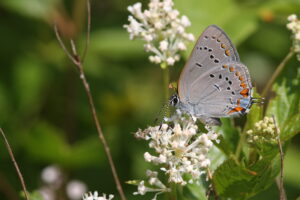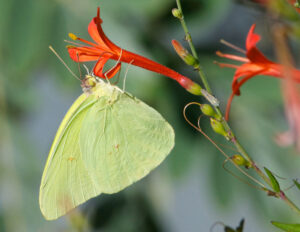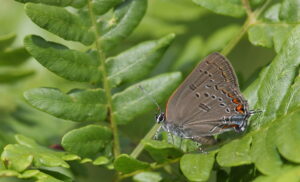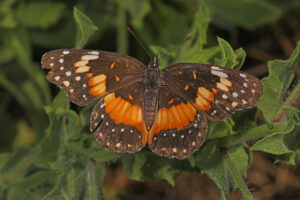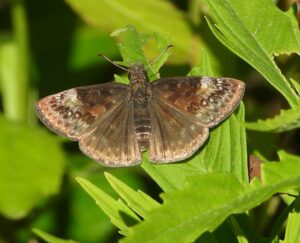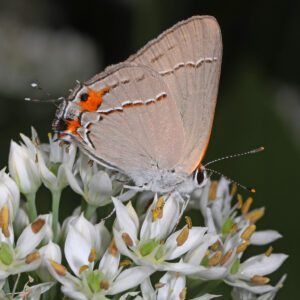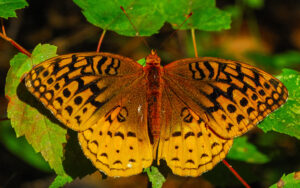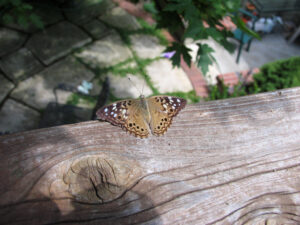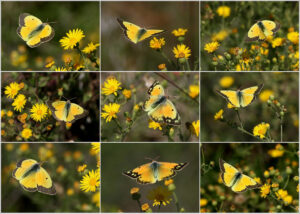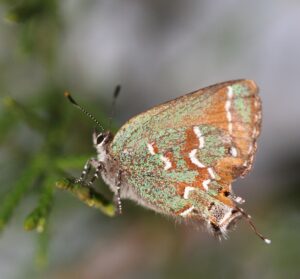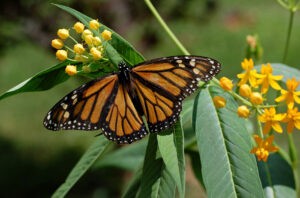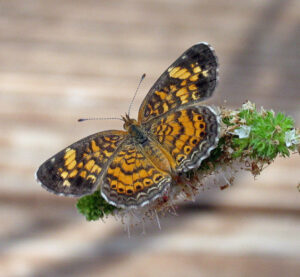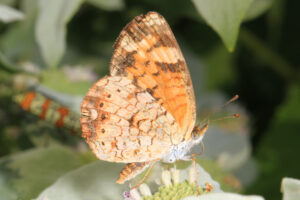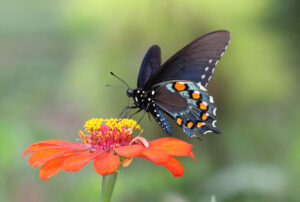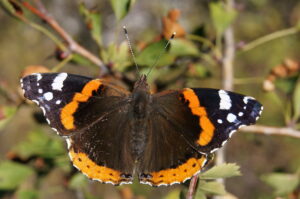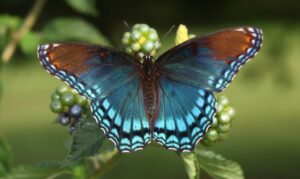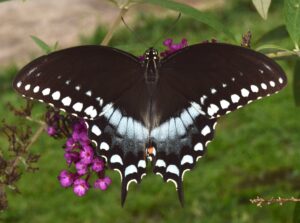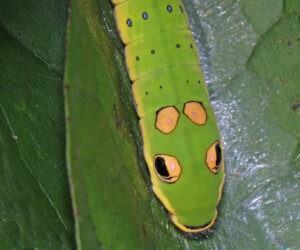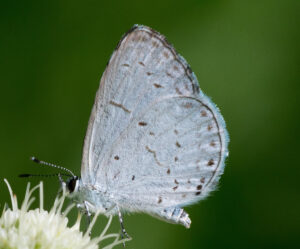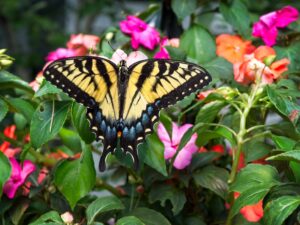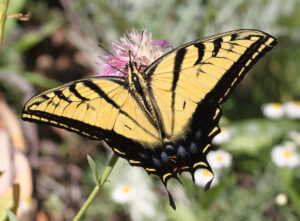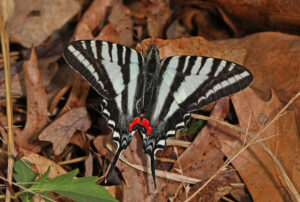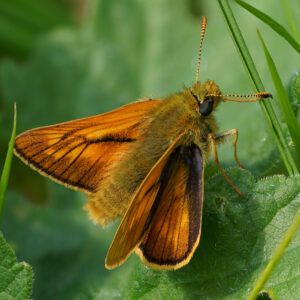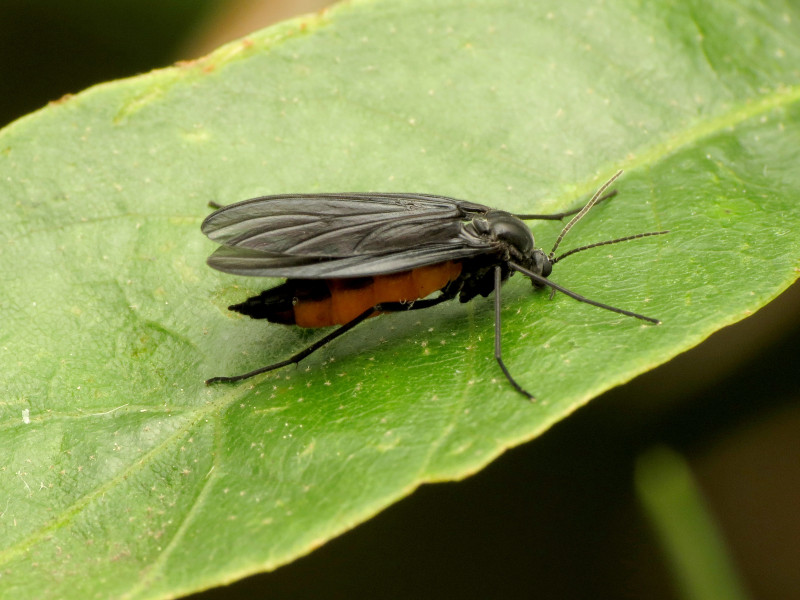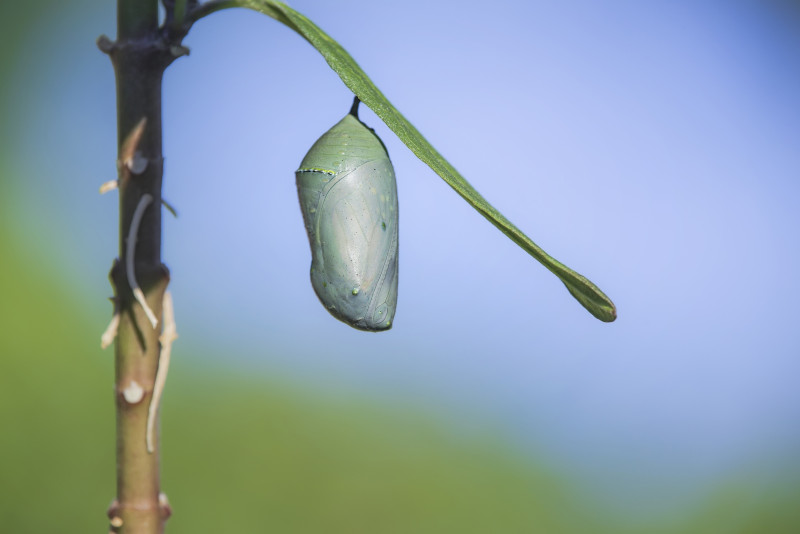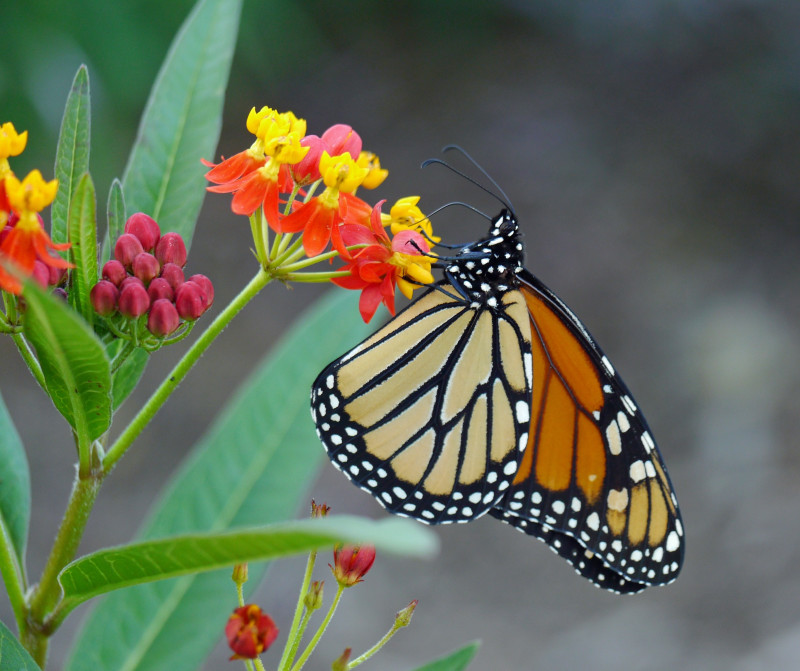Look for these butterflies in your yard, depending on where you live and your own particular environment. When you learn the names of those you see in your yard and know a bit about them, it makes watching them all the more enjoyable. Take note, too, of the plants they prefer and consider adding more to make your yard especially inviting.
(WelcomeWildlife.com wishes to thank the talented photographers whose wonderful photos enhance this page. Acquiring large numbers of photos is cost-prohibitive for a small site such as this, but these generous photographers offer their images free under Creative Commons Licenses or in the public domain. This allows us to provide informative content paired with captivating visuals.)
Acadian Hairstreak, Satyrium acadica
Willows are hosts for Acadian Hairstreak caterpillars, which feed on the leaves. Look for adults, which have a wingspan of only about 1.25 inches (3.1 cm), in June and early July, as they nectar on flowers such as milkweeds and thistles. They range throughout the northeastern quarter of the United States and southern Canada.
Cloudless Sulphur, Phoebis sennae
Flowers with long tubes, such as the Red Buckeye, Cardinal Flower, hibiscus, bougainvillea, and pentas attract Cloudless Sulphurs. Their caterpillars commonly feed on the leaves of plants in the pea family (Fabaceae).
Edwards’ Hairstreak, Satyrium edwardsii
These tiny butterflies inhabit northeastern and north-central North America. As adults, they visit a variety of nectarous flowers, but especially milkweeds and White Sweet Clover. They overwinter as eggs on oak trees, especially Scrub Oak and Black Oak. Their caterpillars hatch in the spring and feed on oak leaves.
Bordered Patch, Chlosyne lacinia
Sunflowers and black-eyed Susans (Rudbeckia sp.) are favorite host plants. Look for Bordered Patch Butterflies from April to November in open fields, hillsides, fencerows, and woodlands from the south-central and southwestern U.S. They have a highly varied appearance with a 2.0-inch (5 cm) wingspan. Most look similar to the one shown here.
Columbine Duskywing, Erynnis lucilius
Duskywing species can be hard to identify, so look closely. The Columbine Duskywing is found from southern Quebec to Manitoba and south into the northeastern U.S. Look for them butterflies in early May to mid-June. They use the American Red Columbine, Aquilegia canadensisas, as a host for their caterpillars.
Gray Hairstreak, Strymon Melinus
The most common hairstreaks in N.A., attract them to your yard with goldenrod, white sweet clover, mint, and milkweed. Small and delicate with a 1.3 inch (3.3 cm) wingspan, their wings are mostly displayed upright as they perch on flowers. Note the bluish-gray coloring, red spot, and white-tipped “tails” on the hind wings. They’re seen in northern ranges from May to September and February to November in the South.
Great Spangled Fritillary, Speyeria cybele
These fritillaries are widespread in the U.S. and southern Canada in meadows, moist forests, woodland edges, and city gardens. Not only bright orange, but their 2.5 to 3.0 inch (6.3–7.6 cm) wingspan makes them easily seen as they sip nectar from thistles, milkweeds, and others. Plus, they’re often seen in groups. Females lay eggs in the fall on violet leaves. The caterpillars hide off of the plant in the daytime and feed on it at night. Fritillaries overwinter as caterpillars.
Hackberry Emperor, Asterocampa celtis
don’t visit flowers. Instead, they sip rotting fruit, tree sap, dung, and animal carcasses. They inhabit the lower central and western U.S. Hackberry trees are their only host plants. This one is posing in a typical butterfly resting position – all 4 wings upright and together. When basking, butterflies spread all their wings out horizontally to catch the sun’s rays.
Harvester Butterfly, Feniseca tarquinius
Also called Valentine Harvester, this is a rarity—a carnivorous butterfly, the only one in the U.S. A gardener’s friend, they feed on aphids. They Inhabit the eastern U.S. from southern Canada to the Gulf Coast. The genus name, Feniseca, is Latin for “a mower,” and tarquinius is from the name of an Etruscan king known for his tyranny.
Juniper Hairstreak, Callohprys gryneus
Males perch at the top of Eastern Redcedars (one of the few host plants females will use) all day, hoping to mate. The caterpillars feed on the tips of new foliage and are well-hidden until they grow large. Birds, however, finish off many, if not most, before they can mature. Those that make it to adulthood feed on nectar from Butterfly Weed, White Sweet Clover, dogbane, and others.
Monarch, Danaus plexippus
Monarchs are known for their migrations. But those migrating south in the fall aren’t the same ones who moved north in the spring. They’re the last of several generations “born” over the summer. Earlier generations —those that emerged in the summer—lived only a few weeks, but the very last adults to emerge will live through winter and into next spring. In the fall, the last generation’s reproductive system stops developing, then starts up again as they migrate north. Last fall’s Monarchs parent the new year’s first generation.
Monarchs begin their migration north in March, and they can’t delay. By then, the last of the extra body fat they put on the previous fall is almost gone, and they need food. And they need water, too, as their winter area in Mexico is dry. Although they have only a few more weeks to live, and they need to get going, they can’t move too fast. Milkweed plants need to be leafing out as the Monarchs move north, as they’re the only plants their caterpillars will eat.
Orange Sulphur, Colias eurytheme
One of the most widespread and common butterflies in N. A., the Orange Sulphur ranges from coast to coast. In southern areas, they begin emerging from hibernation in March. In northern areas, look for them starting in June. With a wingspan of 1 3/8 – 2 3/4 (4.1–7.0) inches, they’ll be easy to spot in your garden. Adults nectar from all kinds of flowers, including milkweeds, asters, and dandelion. Hosts for their caterpillars are in the legume family, which includes peas, beans, lentils, and white clover.
Males are yellow- to bright orange on their upper surface, and females range in color from white or pale to bright yellow. Females have spots on the outer edge of their wings, males do not.
Pearl Crescent, Phyciodes tharos
This is the dorsal side of a Pearl Crescent, demonstrating how butterflies hold their wings when at rest or basking in the sun.
Pearl Crescent, Phyciodes tharos
Here’s the Pearl Crescent again, looking pretty different from the image above. That’s because, this time, the wings are folded. When a butterfly’s wings are held together, we see the underside (ventral). A difference in patterning and coloration, sometimes pretty dramatic, is common among butterflies. It helps in identifying them if you can get a good look at both the dorsal and ventral sides.
Pipevine Swallowtail, Battus philenor
To attract this beautiful butterfly to your yard, plant hosts from the Aristolochiaceae family, such as Dutchman’s Pipe and Virginia Snakeroot. These plants are toxic to most animals, but Pipevine caterpillars are immune. Interestingly, eating the plant makes them toxic, too, even when they become adults. This helps keep Pipevines safe throughout their lives, as most wildlife won’t eat them.
Red Admiral, Vanessa atalanta
One of the few migrating butterflies, Red Admirals inhabit N.A., Europe, and Asia. They spend summer across the U.S. and into Canada. In the fall, they move down to warmer areas: south Texas, the Carolinas, Georgia, and other parts of the deep south. The following spring, a new generation migrates north. Their young caterpillars live and eat within folded leaves of nettles, pellitory, or hops. When older, they form a nest of leaves tied together with silk. Adults feed on sap, fermenting fruit, and various nectar plants, including milkweeds, red clover, and aster.
Red-spotted Purple, Limenitis arthemis
If your yard is adjacent to open woodlands and forest edges in the eastern half of the U.S. (with some isolated populations in Arizona and New Mexico), these beautiful butterflies might be visiting your yard. Adults feed on sap, rotting fruit, carrion, dung, and sometimes nectar from privet, viburnum, spirea, and other plants. The last caterpillars of the season go into hibernation. (More about Red-spotted Purples and their connection to Red Admirals on this page.)
Spicebush Swallowtail, Papilio troilus
The Spicebush Swallowtail flies close to the ground and, uniquely, flutters its wings even while feeding. They inhabit the eastern half of the U.S. and Canada, in forests, forest edges, and woody swamps. They visit suitable urban areas, too. Plant Spicebush, Lindera benzoin, to attract them; it’s their favorite host plant. It likes shade to part-shade.
Spicebush Swallowtail, Papilio troilus
This Spicebush Swallowtail caterpillar seems to have wonky eyes! But not really; those are just plain ole spots. They’re meant to mimic common green snakes, which helps them ward off predators, mainly birds. There are other species that also have spots meant to resemble eyes. This individual is a late-stage “instar,” meaning it will soon form a chrysalis and pupate. During an earlier instar, they are dark brown and resembled bird droppings, which, of course, makes them look unpalatable to predators. Those larvae entering pupation in the fall spend the winter that way and emerge the following spring.
Spring Azure, Celastrina ladon
Plant a Flowering Dogwood tree, Cornus florida, as a host for the Spring Azure. (A bonus for you: the Flowering Dogwood is considered by many to be the most spectacular of the flowering native trees.)
The Spring Azure is seen across most of the U.S. and Canada. Their habitat: forest edges, fields, wooded marshes, and urban areas with suitable habitat. Adults nectar on dogbane, privet, common milkweed, and other species.
Tiger Swallowtail, Papilio glaucus
The Tiger Swallowtail has Eastern and Western versions. They look almost alike and were originally thought to be a single species. You’ll know which one visits your yard by where you live. The Western Tiger Swallowtail, Papilio rutulus, inhabits the western U.S., and the Eastern Tiger Swallowtail, Papilio glaucus, is seen in the eastern half of the U.S.
Two-tailed Swallowtail, Papilio multicaudatus
These differ from similar-looking swallowtails by thinner and fewer black stripes on the wings, and each hind wing has two tails—one long, one short. Their 5-inch (12.7 cm) wingspan makes them easy to spot in a garden. They inhabit the western U.S. and British Columbia. Adults sip nectar from milkweeds, thistles, California Buckeye, lilac, and others. Their host plants include milkweed, chokeberry, willow, cherry, poplar, and ash.
Zebra Swallowtail, Protographium marcellus
Use Pawpaw trees as a host plant because the Zebra Swallowtail is usually found nearby. Native to the eastern U.S. and Canada, these large butterflies—a wingspan up to 4 inches (10 cm)—are mostly now gone from Florida due to habitat loss. Look for them from late March to August in the northern range and up to December in the South.
Skipper butterflies
Skippers are in the same order as butterflies. But they’re different in several ways and grouped in a separate superfamily. One way to distinguish them is their resting position. Most (not all) hold their forewings upright and their hind wings horizontal. Butterflies, on the other hand, hold all four wings upright and together when resting and all four horizontal when basking or feeding.
The antennae of skippers are different from butterflies. Butterfly antennae have clubbed tips. Skippers have clubbed tips, too, but they also have a little hook on the end.
Skippers tend to quickly dart, or “skip,” from place to place. Most skippers are tan, orange, brown, or gold, and often with patterning so subtle, it can be hard to identify them.


